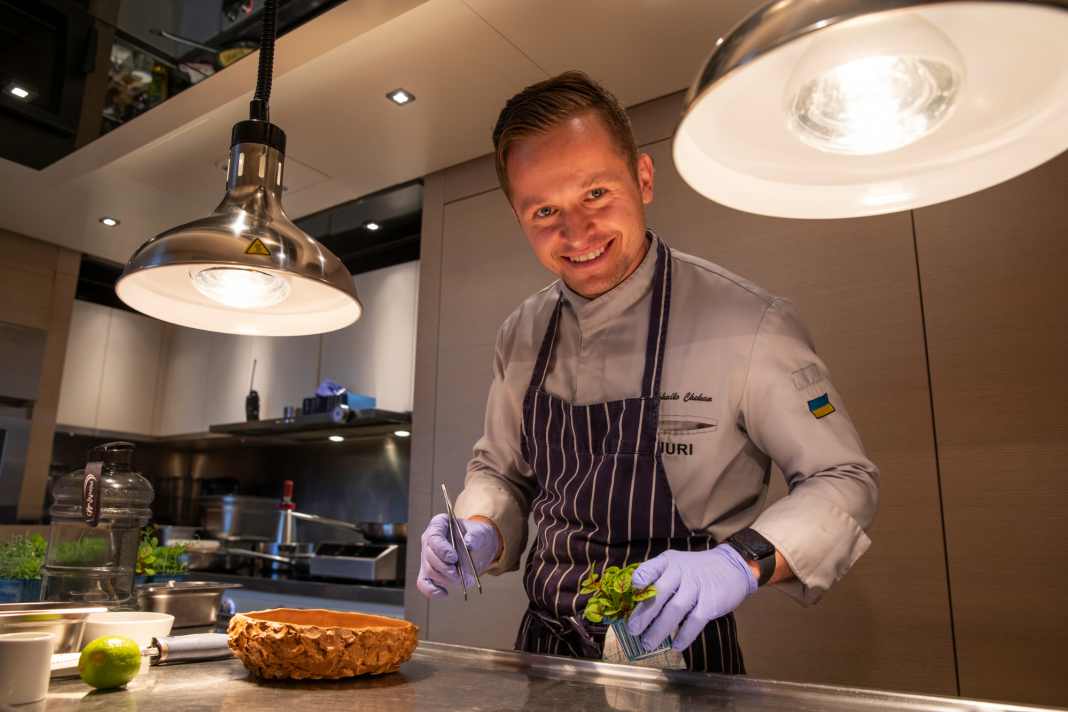





Mykhailo Chekan comes from Ukraine and began his culinary journey in an Italian restaurant in Kiev, which was voted the second best restaurant in the country for several years and is still one of the best known today. The head chef there often worked in Italy and brought a wealth of knowledge back with him. As a result, Chekan also developed a deep understanding of Italian cuisine, which still influences his cooking today.
He then worked on a German cruise ship, where he got to know many international cuisines - a good preparation for the world of yachts. His current job encouraged him to take part in culinary competitions. His first, a fusion challenge, was judged by Michelin-starred chefs. Despite the immense pressure, Mykhailo Chekan won. He describes his style as "a combination of Italian cuisine with Thai flavours."
What was the first yacht you worked on? And what was the galley like?
My first stop was "A+", a 147 metre superyacht owned by a royal family in the United Arab Emirates. The galley was a paradise, equipped with state-of-the-art appliances and an unlimited budget, allowing me to expand my knowledge of different cuisines and techniques. The two and a half years I spent there were very important for my culinary skills. I then worked briefly on board "Rising Sun", a 138 metre yacht, before moving to "Nuri". "Nuri was an exciting challenge: I had to run the galley all by myself. That was the most rewarding experience so far.
What should a good superyacht galley have? Which devices are a must and what could you do without?
One observation I have made is that many new yachts prioritise aesthetics over functionality in the galley. For a professional chef, practical equipment is essential. A high quality Rational oven is very important, offering functions such as steaming, roasting and humidity control to ensure perfect results every time. Equally essential are a powerful induction hob, a sous vide appliance, a Thermomix and a Pacojet for preparing ice cream. A blast chiller is an added luxury, but makes a big difference.
What do you think of open galleys in the centre of the main salon, flanked by a dining area and lounge?
I admire open kitchens in restaurants as they create a nice experience where chefs and guests can interact. However, on a yacht this arrangement can be impractical for the chefs. The galley becomes part of the interior and needs to be constantly maintained and presented, which can distract from the cooking.
Do you like cooking when the owner is watching you or when he wants to sit down with you?
I enjoy it when the owner comes into the galley to chat with me, or when I prepare a barbecue outside and interact with the guests. I've also organised masterclasses for guests, which is a great way to share my passion for cooking.
The demands of owners have certainly changed over the years. Is it perhaps less formal, more vegetarian or healthier on a superyacht today?
Yes, yacht catering has evolved over the years. Originally it was about sumptuous, rich dishes, but now there is an increasing emphasis on healthier options. This change has allowed me to grow with the trends and incorporate more fermented foods, open fire cooking, lean meats, seafood and vegetables into my repertoire.
What is always on the owners' wish list, for example in the Mediterranean region?
I am lucky to work with owners who are open to trying new dishes. On cruises, I source fresh, local fish and adapt the menus to the region we are in. In Italy, for example, I might prepare Italian dishes twice a day, while the rest of the time I try out other cuisines such as Asian or Mexican.
What do US customers prefer, what do Europeans like?
American guests in the Mediterranean often prefer local flavours to immerse themselves in the experience, while European guests tend to be more adventurous. However, both are increasingly asking for healthier dishes.
What doesn't work at all?
I avoid ingredients such as okra or bitter gourd as they are not so popular with European guests.
What's your secret dish when the owner of the superyacht spontaneously comes on board with friends in tow and says: "We need a quick snack, a bite to eat before we go to a party?"
For quick snacks or canapés, I often make hummus with crudités, which is a guest favourite. For canapés, I use fresh fish and make tartlets or sashimi canapés, which are always a hit, especially in summer.
Have you ever had a dinner that went completely wrong?
I've never failed to plate all the courses on a menu, but sometimes I'm not completely satisfied with the result because I don't have enough time to try out new dishes. Afterwards, I make detailed notes on how I can do it better next time. The ability to adapt, learn and improve is one of the most rewarding aspects of this job.
Where do you buy fresh ingredients for the superyacht while travelling?
As for fish, I rely on the local fishermen every few days when I'm at sea. On small islands, there are often reliable sources of freshly caught fish, so it's easy to source quality seafood. However, some products can be more difficult to source, especially baby vegetables, fine micro-vegetables or specialities such as truffles and caviar. These are often not available at normal island markets.
How do you plan, how often do you need to replenish the supplies and fridges?
I organise fresh produce for the first four days of a trip in advance and work closely with suppliers who specialise in sourcing premium products. These suppliers ensure that I have everything I need to fulfil the high standards of yacht cuisine, even in remote locations.

